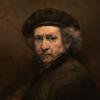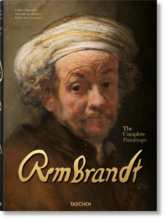More about An Old Man in Military Costume
- All
- Info
- Shop

Contributor
Rembrandt continues to impress with his vaguely depressing array of browns and grays.
This elderly gentleman appears only slightly less miserable than the artist himself in his self-portraits. On the grim-faced beauty perches a gaudy and ill-advised hat, part of a military uniform sure to stand out on the battlefield. The portrait may be a patriotic nod to the conflict du jour, the battle for Dutch independence, but the real intrigue lies under the surface (pun intended). Since 1968, increasingly accurate x-ray scans have gradually revealed a second painting underneath this one, a young man in green. We can’t all be the lucky few whose faces grace the walls of the Getty Center.
The gentleman in question has joined the ranks of of other hidden masterpieces, including no less than three portraits buried underneath the Mona Lisa. Even the greatest artists, it seems, can run into a creative block. Or maybe they just ran out of materials and used the ol' reduce, reuse, recycle ethos?
Rembrandt, in all his reclusive glory, was the bad boy of the Dutch Golden Age. He fathered a bastard, squandered his savings like a drunkard in Vegas, and dared to paint with an indecent amount of texture before van Gogh made it cool. According to less than reputable 17th century biographer Arnold Houbraken, Rembrandt kept his audience at a distance from his paintings to conceal sloppy brushstrokes. Could masterpieces hidden beneath be the explanation behind Rembrandt’s notoriously thick paintings?
Regardless of cause, Rembrandt’s scandalously shabby technique made him the favorite punching bag of admittedly pompous 17th century critics and the subject of some raunchy folklore. Biographers of the century could be about as credible as modern-day clickbait.
The aforementioned Houbraken claimed that Rembrandt insisted on adding his own dead pet monkey’s likeness to a commissioned portrait, a gesture we’re sure was just as awkward as it sounds. Rembrandt’s pets must have been alive and well at the time of this portrait, as none have been memorialized in the work. With all respect to the master printmaker, we’re not convinced the solemn rendition couldn’t use a baboon or two.
Sources
- "An Old Man in Military Costume." The J. Paul Getty Museum. Accessed April 23, 2017. http://www.getty.edu/art/collection/objects/673/rembrandt-harmensz-van-….
- Boehm, Mike. "Getty learns more about young man lurking beneath its Rembrandt 'Old Man'" Los Angeles Times. September 1, 2015. Accessed April 23, 2017. http://www.latimes.com/entertainment/arts/culture/la-et-cm-getty-learns…-
- Cumming, Laura. "Rembrandt: The Late Works review – dark, impassioned, magnificently defiant." The Observer. October 18, 2014. Accessed April 23, 2017. https://www.theguardian.com/artanddesign/2014/oct/19/rembrandt-late-wor…
- Heilpern, Will. "'Mona Lisa': Hidden portraits 'found underneath'" CNN. December 08, 2015. Accessed April 23, 2017. http://www.cnn.com/2015/12/08/world/mona-lisa-hidden-portrait/.
- Hochfield, Sylvia. "Rembrandt: Myth, Legend, Truth." ARTNEWS. July 1, 2006. Accessed April 23, 2017. http://www.artnews.com/2006/07/01/rembrandt-myth-legend-truth/.












